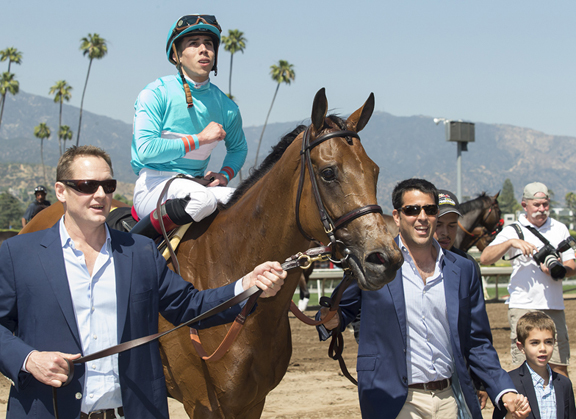By T. D. Thornton
Congressmen Andy Barr (R-KY) and Paul Tonko (D-NY) picked a curious time last Thursday to introduce H.R. 2651, the Horseracing Integrity Act of 2017. Generally, government entities that make announcements just prior to a three-day holiday weekend want the news to get buried, not noticed.
The bill is a rewrite of the 2015 version of similar legislation that would establish an authority to create and implement a national uniform medication program with input from the horse industry. The initial bill was a good start, but it seemed to bite of more than its supporters could chew. The concept was roundly debated, thoughtful revisions were filed six weeks later, then talk and action died off when Congress broke for summer recess and the bill never came close to being voted upon.
Like the initial version, the new bill has the potential to initiate a significant paradigm shift in an industry that has made good progress–but has not completely dealt with–problems related to drug cheating and therapeutic medication abuse.
In covering the topic of federally mandated independent drug oversight over the past two years, my chief takeaways are:
1) The vast majority of stakeholders agree that something needs to be done. 2) Rank-and-file participants in the sport want a level playing field that can only be brought about by significant change. 3) Vocal pockets of participants are content with the status quo, chiefly because they don't want to jeopardize their fiefdoms or profit streams. 4) The Thoroughbred industry is increasingly defined by its differences and problems–as opposed to working together on a common consensus that might not please everybody, but is vital for the long-term health of the sport.
Funding for independent oversight has remained the most vague sticking point. Supporters of the bill have yet to state a ballpark annual budget for such an overarching program. Considering that Major League Baseball and the National Football League each reportedly spend north of $10 million annually for their drug-testing programs, it is conceivable that the Thoroughbred industry, with exponentially larger numbers of participants to test (both in- and out-of-competition) would far exceed those annual budgets.
It is also troubling that loans and donations from unspecified sources are stated in the bill as preliminary funding mechanisms, because those methods open a door to potential conflict-of- interest issues. And once the program is up and running, you can expect that some individual state racing commissions will balk or outright refuse to pay the monthly bills that will come due (even though the per-starter fee scale seems quite fair). The question of whether states' rights are being trumped by federal oversight will be also a very legitimate question that is sure to be raised–most likely in the form of a lawsuit in federal court.
Several weeks ago I attended the Pan American Conference in Washington, D.C., which brought together racing administrators, executives, and horsemen from around the globe. Yet the two speakers whose talks resonated the most with me both stated up front that they knew very little about horse racing and had no involvement in the sport.
One was Richard McLaren, an internationally recognized sports law expert who has led numerous international anti-doping investigations. The other was Dr. Larry Bowers, a chemist with five decades of experience who retired last year from the United States Anti-Doping Agency (USADA) after serving as its chief science officer for nearly a decade.
After two years of hearing racing insiders going around and around repeating the same pro-and-con arguments about independent drug oversight, these two outsiders illuminated the subject in new ways for me by giving succinct analyses of the cultures of doping in other sports. Without referring to any racing-related specifics, they both nailed the cultural dysfunctions within our industry by pointing out common patterns that exist in any sport where doping is not properly controlled.
“The effectiveness of procedural safeguards go hand in hand with the attitude [within] the sport,” McLaren said. “And where the culture of doping occurs, the safeguards simply don't work.”
Added Bowers: “Anti-doping is really not about catching people. It's really about deterring people from doing that behavior in the first place. [But] if the sanction isn't significant compared to what the benefits are, you get no deterrence. If it takes forever to get a sanction put in place and the [cheater] benefits from their [ill-gotten] winnings, then again you lose deterrence….If you have a particular group of people who seem to be outside of the rules, that undermines the entire program.”
Sometimes it takes hearing the message from a different messenger who doesn't have a stake in the game before it really hits home. (You can read the full article about their talks here).
California OK's OOC Breeders' Cup Tests
The decision by the California Horse Racing Board (CHRB) on Thursday to allow the Breeders' Cup to conduct out-of-competition (OOC) testing and to ban horses from the Nov. 3 and 4 championships if they come up positive for a prohibited substance was a sensible move. The CHRB is in the process of instituting its own OOC rules, but because they might not be in place far enough in advance of the Breeders' Cup at Del Mar to be effective, the CHRB took action to allow the Breeders' Cup's OOC protocol to go into effect.
This closes a loophole that resulted in Masochistic (Sought After), the second-place finisher in the 2016 GI Breeders' Cup Sprint at Santa Anita Park, being disqualified months later after testing positive for the prohibited anabolic steroid stanozolol. Under the new protocol that will be in effect for the Breeders' Cup races only, such a positive will presumably be flagged in pre-race OOC testing, and the horse won't even get to start.
“The incident brought to light the fact that California has in place a steroid rule that allows the administration of a steroid with the filing of a confidential [disclosure], and subsequently the only violation takes place if and when a horse tests positive during a race,” Craig Fravel, the chief executive officer and president of the Breeders' Cup, testified at the CHRB meeting. “You know, I'll be frank. I was personally surprised because most of us, I think, five or six years ago believed that we had virtually eliminated steroid administration from racing or training in general.”
The OOC testing program for the championships at Del Mar will align with existing Association of Racing Commissioners International and Racing Medication & Testing Consortium rules.
“We're really trying to move the clock forward here and be proactive on this,” Fravel said. “I should add it's particularly important in the case of the Breeders' Cup. We are a truly international championship. We have horses coming from all over the world, from South America, from France, from Great Britain and Ireland, and in order to attract those horses to race against American horses, they have to have the confidence they're not racing against horses that have an advantage over them in terms of training.”
Fan-Fave Distaffers Set to Shine
With older male kingpin Arrogate (Unbridled's Song) pointing for races deeper into the summer and the 3-year-old division without a clear-cut leader, two fan-favorite distaffers are stepping up as “now” horses who always seem to put on a good show, befitting their billings as star attractions.
Lady Eli (Divine Park)'s half-length win at 3-5 odds in the GI Gamely S. at Santa Anita on Saturday was more impressive than it might have looked, and the effort was worthy of announcer Michael Wrona's “courage exemplified in a racehorse” call at the finish. The 5-year-old mare's 7-3-0 record from 10 starts stands on its own, but her story will always be captivating considering she was away from racing for over a year in 2015-16 after stepping on a nail and developing laminitis in both front feet. She not only recovered from that life-threatening predicament, but has regained top form after her owners opted to keep her in training for 2017 instead of retiring as a broodmare.
“The fact that she can come back and do this…it's amazing, it's absolutely amazing,” said Jay Hanley, a part owner in the Sheep Pond Partners group. “All we can do as owners is try to be good stewards and that's our job…. I feel like we wanted to bring her back, mostly for the fans. It's to showcase her for the fans. The fans that are here today, I'm sure many are here to see her.”
While turfer Lady Eli shipped from East to West for her Grade I stakes score, the top dirt distaffer in the country will go the other way–from her California base to a New York race–for her seasonal debut.
Songbird (Medaglia d'Oro), the 2- and 3-year-old filly champion, is on target to make her first 2017 start in the GI Ogden Phipps S. on the GI Belmont Stakes undercard June 10. The Phipps will mark Songbird's first start since finishing a determined second in the GI Breeders' Cup Distaff last fall. Songbird, now 4, ran up the score through her juvenile and sophomore seasons, going 11-for-11 before suffering the first defeat of her career at the hands of three-time champion Beholder (Henny Hughes). Songbird worked six furlongs Thursday in 1:13.80 (2/16) at Santa Anita.
“She's bigger than last year, she's put on weight, looks good. She's been training the same, she doesn't act any different that way,” said trainer Jerry Hollendorfer. “Mike Smith was up and he's very happy with the way she's coming along. We're looking to try to have a good campaign with her.”
Not a subscriber? Click here to sign up for the daily PDF or alerts.






